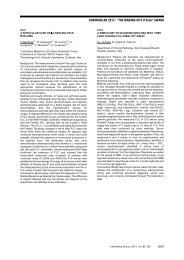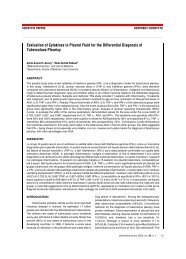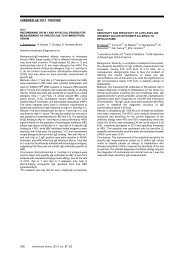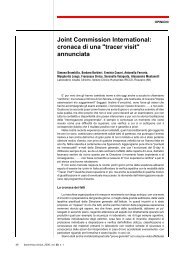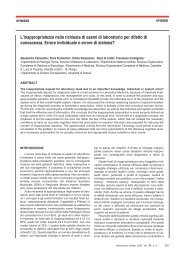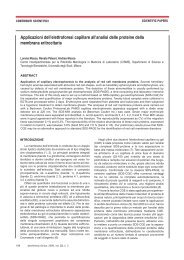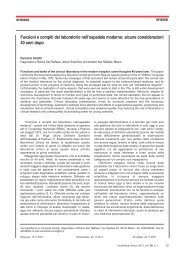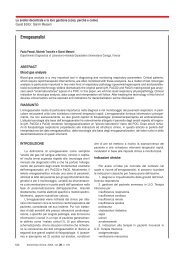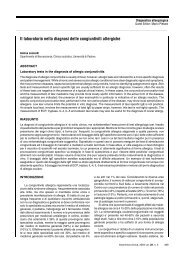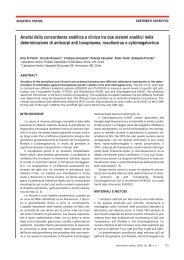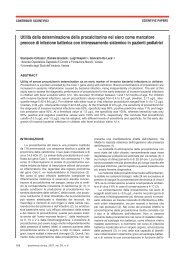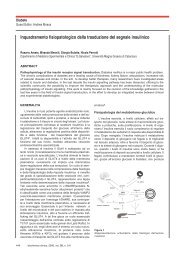Field evaluation of the GeneXpert system for detection of ... - SIBioC
Field evaluation of the GeneXpert system for detection of ... - SIBioC
Field evaluation of the GeneXpert system for detection of ... - SIBioC
You also want an ePaper? Increase the reach of your titles
YUMPU automatically turns print PDFs into web optimized ePapers that Google loves.
CONTRIBUTI SCIENTIFICI SCIENTIFIC PAPERS<br />
<strong>Field</strong> <strong>evaluation</strong> <strong>of</strong> <strong>the</strong> <strong>GeneXpert</strong> <strong>system</strong> <strong>for</strong> <strong>detection</strong> <strong>of</strong> thrombophilia<br />
associated mutations: a six-month experience in a small laboratory<br />
Gianluca Gessoni 1,2, Sara Valverde 2, Rosa Canistro 3, Francesca Marangon 2, Fabio Manoni 4<br />
1Transfusional Service, 2Service <strong>of</strong> Laboratory Medicine, and 3Service <strong>of</strong> Oncology and Hematology, Ospedale Civile,<br />
Chioggia, VE<br />
4Service <strong>of</strong> Laboratory Medicine, Ospedale Civile, Monselice, PD<br />
ABSTRACT<br />
Factor V Leiden G1691A mutation (FVL) and prothrombin G20210A mutation (GPro) are <strong>the</strong> most common inherited<br />
mutations associated with thrombophilia. <strong>GeneXpert</strong> HemosIL Factor II and Factor V assay is a fully automated assay<br />
that is able, in less than 35 min, to allow simultaneous <strong>detection</strong> <strong>of</strong> FVL and GPro. Test <strong>for</strong>mat, based upon single test<br />
cartridge, was designed to minimize waste and to permit daily analytical sessions. In this study we evaluated <strong>the</strong><br />
per<strong>for</strong>mance <strong>of</strong> <strong>GeneXpert</strong> <strong>system</strong> in <strong>detection</strong> <strong>of</strong> FVL and GPro mutations. 211 consecutive patients, enrolled from<br />
March to August 2011, were studied. All samples were evaluated by using <strong>the</strong> <strong>GeneXpert</strong> <strong>system</strong> in comparison with<br />
Roche Light Cycler assay. By using both assays, 51 FVL heterozygous, 3 FVL homozygous, 1 GPro homozygous, 10<br />
GPro heterozygous, 5 combined FVL-GPro heterozygous and 141 normal subjects were identified, with a 100%<br />
concordance between <strong>the</strong> two assays. During six months we observed 15 invalid sample results using <strong>GeneXpert</strong><br />
(7.1%) that were retested after dilution. Consequently, <strong>the</strong> tests/results ratio was 1.07. In our experience, <strong>the</strong> assay was<br />
<strong>the</strong>re<strong>for</strong>e af<strong>for</strong>dable and characterized by a good rate between number <strong>of</strong> carried out tests and released results.<br />
INTRODUCTION<br />
Venous thrombosis is <strong>the</strong> third most common<br />
vascular disease after ischemic heart disease and<br />
stroke. It is common in whites, affecting 1 in 1000<br />
individuals every year, and is strongly associated with<br />
life-threatening pulmonary embolism. In addition to aging<br />
and circumstantial predisposing factors (e.g., surgery,<br />
pregnancy or immobilization), genetic risk factors, due to<br />
molecular abnormalities <strong>of</strong> components <strong>of</strong> <strong>the</strong><br />
coagulation pathway, leading to hypercoagulability and,<br />
in turn, to thrombophilia, have been found in subjects,<br />
who suffered thromboembolic disease. In subjects from<br />
different ethnic groups, a common mutation [a G-to-A<br />
transition at nucleotide 1691 within <strong>the</strong> factor V gene: FV<br />
Leiden (FVL)], leading to resistance to activated protein<br />
C (aPC), has been found in up to 20% <strong>of</strong> cases <strong>of</strong><br />
patients with deep venous thrombosis (1, 2). Ano<strong>the</strong>r<br />
common mutation, a G-to-A transition at nucleotide<br />
position 20210 within <strong>the</strong> prothrombin gene locus (GPro),<br />
has been described, <strong>the</strong> A allele carriership being<br />
associated with a higher risk <strong>of</strong> venous thrombosis and<br />
accounting <strong>for</strong> up to 14% <strong>of</strong> cases <strong>of</strong> deep venous<br />
thrombosis (3, 4).<br />
FVL is an autosomal dominant condition that exhibits<br />
incomplete dominance and results in a factor V variant<br />
20 biochimica clinica, 2012, vol. 36, n. 1<br />
that cannot be as easily degraded by aPC. The gene<br />
coding <strong>the</strong> protein is referred to as F5. FVL is<br />
characterized by a single nucleotide polymorphism in<br />
exon 10, in position 1691 with a G to A substitution<br />
(G1691A); it also predicts a single amino acid<br />
replacement [arginine to glutamine (R506Q)] at one <strong>of</strong><br />
<strong>the</strong> three aPC cleavage sites in <strong>the</strong> factor Va. Since this<br />
amino acid is normally <strong>the</strong> cleavage site <strong>for</strong> aPC, <strong>the</strong><br />
mutation prevents efficient inactivation <strong>of</strong> factor V. When<br />
factor V remains active, it facilitates overproduction <strong>of</strong><br />
thrombin leading to excess fibrin generation and excess<br />
clotting.<br />
Evaluation <strong>for</strong> FVL can begin with a test <strong>for</strong> aPC<br />
resistance. Indeed, in ~95% <strong>of</strong> cases <strong>the</strong> aPC resistance<br />
is due to a FVL mutation. If resistance is present, <strong>the</strong>n a<br />
genetic test <strong>for</strong> FVL gene mutation has to be per<strong>for</strong>med,<br />
both to confirm <strong>the</strong> diagnosis and to determine whe<strong>the</strong>r<br />
<strong>the</strong> subject is heterozygous or homozygous <strong>for</strong> <strong>the</strong><br />
mutation (5, 6).<br />
Prothrombin is <strong>the</strong> precursor <strong>of</strong> thrombin in <strong>the</strong><br />
coagulation cascade; thrombin is required to convert<br />
fibrinogen into fibrin, which is <strong>the</strong> primary goal <strong>of</strong> <strong>the</strong><br />
coagulation cascade. As said, <strong>the</strong> GPro is caused by a G<br />
to A transition in <strong>the</strong> 3'-untranslated region <strong>of</strong> <strong>the</strong><br />
prothrombin (factor II) gene at position 20210. This<br />
condition is associated with a mild increase in plasma<br />
Correspondence to: Gianluca Gessoni, Transfusional Service, Ospedale Civile, Via Madonna Marina 500, 30015 Chioggia (VE).<br />
Tel. 0415534400, Fax 0415534401, E-mail ggessoni@asl14chioggia.veneto.it<br />
Ricevuto: 16.09.2011 Revisionato: 27.10.2011 Accettato: 29.11.2011
SCIENTIFIC PAPERS CONTRIBUTI SCIENTIFICI<br />
prothrombin concentrations and an increased risk <strong>of</strong><br />
venous thrombosis. Diagnosis <strong>of</strong> GPro mutation is made<br />
through specific genetic testing, which can also reveal<br />
whe<strong>the</strong>r <strong>the</strong> patient is heterozygous or homozygous <strong>for</strong><br />
<strong>the</strong> condition. Although prothrombin levels are usually<br />
moderately elevated in subjects with this mutation, <strong>the</strong>se<br />
results are not clinically useful in identifying <strong>the</strong> mutation<br />
(7, 8).<br />
In this study, we evaluated <strong>the</strong> <strong>GeneXpert</strong> <strong>system</strong> <strong>for</strong><br />
combined <strong>detection</strong> <strong>of</strong> FVL and GPro in comparison with<br />
<strong>the</strong> Roche Light Cycler assay, routinely used in our<br />
laboratory.<br />
MATERIALS AND METHODS<br />
Study design<br />
This study was per<strong>for</strong>med in a little clinical laboratory<br />
(about 1,500,000 tests/year) located in a non teaching<br />
300-bed general hospital. Between March and August<br />
2011, 211 consecutive patients, referred to our<br />
laboratory <strong>for</strong> evaluating thrombophilia risk factors, were<br />
studied. These patients were evaluated in duplicate <strong>for</strong><br />
FVL and GPro by using <strong>GeneXpert</strong> and Roche Light<br />
Cycler assays. After approval by <strong>the</strong> local Ethic<br />
Committee, this study was carried out according to <strong>the</strong><br />
principles <strong>of</strong> <strong>the</strong> Helsinki declaration; in<strong>for</strong>med consent<br />
was obtained from all subjects.<br />
For <strong>the</strong> study, blood samples were collected into<br />
vacuum tubes (Becton Dickinson) containing 0.129 M<br />
trisodium citrate and stored at +4 °C up to 6 h, be<strong>for</strong>e<br />
test execution.<br />
Methods<br />
Roche Light Cycler assay<br />
DNA samples were isolated from whole blood with<br />
<strong>the</strong> aid <strong>of</strong> a MagNa Pure LC DNA Isolation kit I, using a<br />
MagNA Pure LC automated DNA isolation instrument<br />
(Roche Molecular Biochemicals). DNA samples were<br />
stored at -20 °C until <strong>the</strong> mutations were investigated.<br />
FVL and GPro mutations were detected with <strong>the</strong> Light<br />
Cycler-Factor V Leiden and Light Cycler-Prothrombin<br />
20210GA mutation <strong>detection</strong> kits (Roche Molecular<br />
Biochemicals), respectively. All mutation-related gene<br />
regions were amplified in 20 µL polymerase chain<br />
reaction (PCR) capillary tubes. After preparation <strong>of</strong> <strong>the</strong><br />
master mixture, 18 µL <strong>of</strong> <strong>the</strong> reaction mixture and 2 µL<br />
(approximately 40 ng) <strong>of</strong> genomic DNA or control<br />
template were added to each Light Cycler capillary tube.<br />
For negative control, PCR grade water was added<br />
instead <strong>of</strong> template. The capillary tubes were sealed and<br />
briefly centrifuged in a microcentrifuge and <strong>the</strong>n placed<br />
into <strong>the</strong> Light Cycler carousel. The PCR products were<br />
detected using 3'-fluorescein (FLU)-labelled and 5'-Red<br />
640-labelled probes. When both probes hybridize in<br />
close proximity, fluorescence resonance energy transfer<br />
(FRET) occurs, producing a specific fluorescence<br />
emission <strong>of</strong> Light Cycler-Red as a result <strong>of</strong> FLU<br />
excitation. The fluorescence intensity depends on <strong>the</strong><br />
amount <strong>of</strong> specific PCR products. Amplification per cycle<br />
can be monitored with <strong>the</strong> Light Cycler instrument. At <strong>the</strong><br />
end <strong>of</strong> <strong>the</strong> amplification process, <strong>the</strong> Light Cycler<br />
instrument increases <strong>the</strong> temperature and <strong>the</strong><br />
fluorescence obtained is plotted against <strong>the</strong> temperature.<br />
The mutations are <strong>the</strong>n identified by <strong>the</strong>ir characteristic<br />
curves. Total assay time is approximately 40 min (9, 10).<br />
<strong>GeneXpert</strong> HemosIL Factor II and Factor V assay<br />
The <strong>GeneXpert</strong> is a s<strong>of</strong>tware-driven cartridge<br />
processor with an integrated <strong>the</strong>rmal cycler with a<br />
fluorescence-based <strong>detection</strong> <strong>system</strong> that adopt singleuse<br />
disposable cartridges to obtain nucleic acid isolation<br />
from whole blood and per<strong>for</strong>m a quantitative PCR.<br />
<strong>GeneXpert</strong> cartridge consists <strong>of</strong> multiple chambers <strong>for</strong><br />
complete automation <strong>of</strong> nucleic acid extraction from<br />
whole blood, PCR reaction, products revelation and<br />
quantification. Cartridges contain chambers <strong>for</strong> sample<br />
introduction, lysis buffer, purification and elution buffers<br />
and all real-time PCR reagents and enzymes in two<br />
freeze-dried beads: bead 1 <strong>for</strong> polymerase and<br />
nucleotides, bead 2 <strong>for</strong> primers and probes. Moreover,<br />
all sample-processing wastes are retained within <strong>the</strong><br />
cartridge. The cartridge also has an attached PCR tube<br />
with fluidic connections to <strong>the</strong> reagents in <strong>the</strong> cartridge<br />
chambers; after introduction into <strong>the</strong> analyzer, this PCR<br />
tube is surrounded by heating/cooling plates and by<br />
optical blocks that enable amplification and real-time,<br />
fluorescence-based PCR product <strong>detection</strong>. At <strong>the</strong><br />
center <strong>of</strong> <strong>the</strong> cartridge is a syringe barrel that has a dry<br />
interface (to minimize potential <strong>for</strong> contamination) with<br />
<strong>the</strong> <strong>GeneXpert</strong> device through a syringe plunger, <strong>the</strong>reby<br />
allowing <strong>the</strong> movement <strong>of</strong> fluids within <strong>the</strong> cartridge and<br />
between <strong>the</strong> PCR tube and <strong>the</strong> cartridge (11, 12). Fluid<br />
movement within <strong>the</strong> cartridge is controlled by a rotary<br />
valve. The valve body contains a cavity in which nucleic<br />
acid purification beads are located. Within <strong>the</strong> cavity<br />
<strong>the</strong>re are inlet and outlet ports that provide <strong>for</strong> fluid<br />
movement over <strong>the</strong> purification beads. These beads are<br />
retained within <strong>the</strong> cavity by screens that cover <strong>the</strong> two<br />
ports on <strong>the</strong> back <strong>of</strong> <strong>the</strong> valve body and a flat cap on <strong>the</strong><br />
front <strong>of</strong> <strong>the</strong> valve body. For nucleic acid capture, a whole<br />
blood lysate solution from one reagent chamber is<br />
flowed through <strong>the</strong> beads within <strong>the</strong> valve body (13, 14).<br />
The bound nucleic acid is <strong>the</strong>n washed, eluted, mixed<br />
with PCR reagents, and dispensed into <strong>the</strong> PCR tube <strong>for</strong><br />
amplification and real-time <strong>detection</strong> by scorpion<br />
technique. Scorpion primers are bi-functional molecules<br />
in which a primer is covalently linked to <strong>the</strong> probe. The<br />
molecules also contain a fluorophore and a quencher. In<br />
<strong>the</strong> absence <strong>of</strong> <strong>the</strong> target, <strong>the</strong> quencher nearly absorbs<br />
<strong>the</strong> fluorescence emitted by <strong>the</strong> fluorophore. During <strong>the</strong><br />
scorpion PCR reaction, in <strong>the</strong> presence <strong>of</strong> <strong>the</strong> target, <strong>the</strong><br />
fluorophore and <strong>the</strong> quencher separate, which leads to<br />
an increase in <strong>the</strong> fluorescence emitted. The<br />
fluorescence can be detected and measured in <strong>the</strong><br />
reaction tube (15-17). Examples <strong>of</strong> revelation curves<br />
obtained are reported in Figure 1.<br />
biochimica clinica, 2012, vol. 36, n. 1 21
CONTRIBUTI SCIENTIFICI SCIENTIFIC PAPERS<br />
Fluorescence<br />
Fluorescence<br />
RESULTS<br />
All <strong>the</strong> samples evaluated in this study were obtained<br />
from patients <strong>of</strong> Italian ancestry, with age from 14 to 69<br />
years (mean, 49 years); 136 (64.5%) were females and<br />
75 (35.5%) were males. Among <strong>the</strong> 211 considered<br />
subjects, by using both Light Cycler and <strong>GeneXpert</strong><br />
assays, 51 FVL heterozygous, 3 FVL homozygous, 10<br />
GPro heterozygous, 1 GPro homozygous, 5 combined<br />
FVL-GPro heterozygous and 141 normal subjects were<br />
identified. We observed a 100% concordance between<br />
22 biochimica clinica, 2012, vol. 36, n. 1<br />
Normal subject FVL homozygous<br />
GPro heterozygous GPro + FVL combined heterozygous<br />
Figure 1<br />
Amplification curves obtained using <strong>the</strong> <strong>GeneXpert</strong> HemosIL Factor II and Factor V assay in different types <strong>of</strong> subjects.<br />
Months<br />
results obtained by using Roche Light Cycler assay and<br />
<strong>GeneXpert</strong> HemosIL Factor II and Factor V.<br />
During <strong>the</strong> 6-month period <strong>of</strong> <strong>evaluation</strong>, we<br />
observed 15 invalid sample results (7.1%). As reported<br />
in Figure 2, <strong>the</strong> prevalence <strong>of</strong> invalid samples decreased<br />
from <strong>the</strong> first to <strong>the</strong> sixth month <strong>of</strong> analytical activity, in<br />
correspondence with an improvement <strong>of</strong> operator<br />
experience. All <strong>the</strong>se samples were retested after 1:5<br />
sample dilution, giving a valid result. So, to produce 211<br />
results we per<strong>for</strong>med 226 tests, with a tests/results ratio<br />
<strong>of</strong> 1.07.<br />
Figure 2<br />
Number <strong>of</strong> per<strong>for</strong>med tests and number <strong>of</strong> invalid tests using <strong>the</strong> <strong>GeneXpert</strong> <strong>system</strong> during six months.<br />
Fluorescence<br />
Cycles Cycles<br />
Cycles Cycles<br />
Fluorescence
SCIENTIFIC PAPERS CONTRIBUTI SCIENTIFICI<br />
DISCUSSION<br />
FVL mutation is <strong>the</strong> most important genetic risk factor<br />
<strong>for</strong> venous thromboembolism and <strong>the</strong> mutation in <strong>the</strong> 3’untranslated<br />
region <strong>of</strong> <strong>the</strong> prothrombin gene seems to be<br />
ano<strong>the</strong>r mild risk factor <strong>for</strong> thrombotic events. It has been<br />
clearly shown that FVL is frequently co-inherited with <strong>the</strong><br />
GPro variant (18). The association <strong>of</strong> <strong>the</strong> two<br />
prothrombotic alleles indicate that <strong>the</strong> prothrombin<br />
variant is an additional risk factor <strong>for</strong> venous<br />
thromboembolism and might contribute to thrombotic<br />
manifestations (19).<br />
Chioggia is a town <strong>of</strong> about 60,000 inhabitants, built<br />
in a group <strong>of</strong> islands in <strong>the</strong> sou<strong>the</strong>rn part <strong>of</strong> <strong>the</strong> Venice<br />
lagoon; <strong>for</strong> logistic reason, <strong>the</strong>re is actually only a street<br />
connecting Chioggia with <strong>the</strong> mainland and, until <strong>the</strong> end<br />
<strong>of</strong> XIX century, <strong>the</strong> town remained quite secluded from<br />
<strong>the</strong> surrounding areas. So that, as previously reported,<br />
we observed a high prevalence <strong>of</strong> FVL in patients<br />
studied to detect thrombophilia risk factors after<br />
thrombosis, even in <strong>the</strong> open population (20-23).<br />
There<strong>for</strong>e, a rapid, simple and relatively cheap test <strong>for</strong><br />
<strong>the</strong> simultaneous <strong>detection</strong> <strong>of</strong> <strong>the</strong> point mutations <strong>for</strong><br />
FVL and GPro was considered <strong>of</strong> great utility in our<br />
laboratory practice. Various different methods <strong>for</strong> <strong>the</strong><br />
simultaneous <strong>detection</strong> were described in literature. All<br />
<strong>the</strong>se methods required DNA extraction followed by<br />
amplification reaction and, <strong>of</strong>ten, fur<strong>the</strong>r analysis <strong>of</strong> <strong>the</strong><br />
amplification products, e.g., enzyme digestion (9, 10, 24,<br />
25).<br />
We reported here our field experience by using a fast<br />
and simple test <strong>for</strong> simultaneous <strong>detection</strong> <strong>of</strong> FVL and<br />
GPro. In our <strong>evaluation</strong>, <strong>GeneXpert</strong> assay <strong>for</strong> combined<br />
<strong>detection</strong> <strong>of</strong> FVL and GPro showed a full concordance<br />
with Roche Light Cycler assay. Ano<strong>the</strong>r advantage <strong>of</strong> <strong>the</strong><br />
simultaneous FVL and GPro assay was <strong>the</strong> reduction in<br />
costs and labour by 50%, because patients with a<br />
mutated allele <strong>for</strong> factor V and/or prothrombin variant are<br />
identified in a single step.<br />
The <strong>GeneXpert</strong> <strong>system</strong> represents an important new<br />
development in <strong>the</strong> field <strong>of</strong> molecular diagnostics. It<br />
automates all steps <strong>of</strong> nucleic acid amplification in a<br />
disposable, micr<strong>of</strong>luidic cartridge. It is a moderately<br />
complex test, but is simple enough to be reliably<br />
per<strong>for</strong>med by individuals without a specific background<br />
in nucleic acid diagnostics. Samples and buffers are <strong>the</strong><br />
only components to be added to <strong>the</strong> cartridge by <strong>the</strong><br />
user. The device has independently controlled and<br />
operated analysis modules that facilitate testing <strong>of</strong><br />
individual samples in a random-access mode. The test<br />
incorporates an internal control, which ensures that <strong>the</strong><br />
entire test <strong>system</strong> is functioning properly, and a probe<br />
check control step, per<strong>for</strong>med be<strong>for</strong>e PCR, to verify<br />
reagent rehydration, probe integrity, and PCR tube filling<br />
in <strong>the</strong> cartridge. So, by using <strong>the</strong> <strong>GeneXpert</strong> HemosIL<br />
Factor II and Factor V assay, it is possible to per<strong>for</strong>m<br />
genetic tests in complete automation from <strong>the</strong> addition <strong>of</strong><br />
whole blood and reagents to <strong>the</strong> cartridge to final results,<br />
without <strong>the</strong> need <strong>of</strong> fur<strong>the</strong>r analytical phase, e.g., DNA<br />
extraction, or <strong>the</strong> need <strong>of</strong> special location <strong>for</strong> molecular<br />
biology assays. The assay <strong>for</strong>mat was studied to<br />
minimize waste and to permit single test execution. The<br />
<strong>system</strong> is uniquely suited <strong>for</strong> clinical applications <strong>of</strong><br />
molecular diagnostics when on-demand testing and<br />
rapid-result capability are needed.<br />
REFERENCES<br />
1. De Stefano V, Rossi E, Paciaroni K, et al. Screening <strong>for</strong><br />
inherited thrombophilia: indications and <strong>the</strong>rapeutic<br />
implications. Haematologica 2002;87:1095-108.<br />
2. Tripodi A, Mannucci P. Laboratory investigation <strong>of</strong><br />
thrombophilia. Clin Chem 2001;47:1597-606.<br />
3. Somma J, Sussman I, Rand J. An <strong>evaluation</strong> <strong>of</strong><br />
thrombophilia screening in an urban tertiary care medical<br />
center: a “real word” experience. Am J Clin Pathol<br />
2006;126:1-8.<br />
4. Sayinalp N, Haznedaroğlu I, Aksu S, et al. The<br />
predictability <strong>of</strong> factor V Leiden (FV:Q506) gene mutation<br />
via clotting based diagnosis <strong>of</strong> activated protein C<br />
resistance. Clin Appl Thromb Hemost 2004;10;265-70.<br />
5. Irdem A, Devecioglu C, Batun S, et al. Prevalence <strong>of</strong> factor<br />
V Leiden and prothrombin G20210A gene mutation. Saudi<br />
Med J 2005;26:580-3.<br />
6. Zoller B, Garcia de Frutos P, Dahlback B. Thrombophilia as<br />
a multigenic disease. Haematologica 1999;84:59-70.<br />
7. Heit J. The epidemiology <strong>of</strong> venous thromboembolism in<br />
<strong>the</strong> community: implications <strong>for</strong> prevention and<br />
management. J Thromb Thrombolysis 2006;21:23-9.<br />
8. Pajič T. Factor V Leiden and FII 20210 testing in<br />
thromboembolic disorders. Clin Chem Lab Med<br />
2010;48(suppl 1):S79-87.<br />
9. Cooper P, Cooper S, Smith J, et al. Evaluation <strong>of</strong> <strong>the</strong><br />
Roche Light Cycler: a simple and rapid method <strong>for</strong> direct<br />
<strong>detection</strong> <strong>of</strong> factor V Leiden and prothrombin 20210<br />
genotypes from blood samples without <strong>the</strong> need <strong>for</strong> DNA<br />
extraction. Blood Coag Fibrinolysis 2003;15:499-503.<br />
10. Nauck M, Marz W, Wieland H. Evaluation <strong>of</strong> <strong>the</strong> Roche<br />
diagnostic Light Cycler factor V Leiden mutation <strong>detection</strong><br />
kit and <strong>the</strong> Light Cycler prothrombin mutation <strong>detection</strong> kit.<br />
Clin Biochem 2000;33:213-6.<br />
11. Moure R, Muñoz L, Torres M, et al. Rapid <strong>detection</strong> <strong>of</strong><br />
Mycobacterium tuberculosis complex and rifampin<br />
resistance in smear-negative clinical samples by use <strong>of</strong> an<br />
integrated real-time PCR method. J Clin Microbiol<br />
2011;49:1137-9.<br />
12. Morelli B, Novelli C, Grassi C, et al. An automation<br />
experience in molecular biology: <strong>the</strong> GeneXper Dx<br />
System <strong>for</strong> FV Leiden and FH 20210A mutation <strong>detection</strong>.<br />
Haematologica 2008;93(suppl 3):76.<br />
13. Kost C, Rogers B, Oberste M, et al. Multicentric beta trial<br />
<strong>of</strong> <strong>the</strong> <strong>GeneXpert</strong> enterovirus assay. J Clin Microbiol<br />
2007;45:1081-6.<br />
14. Raja S, Ching J, Xi L, et al. Technology <strong>for</strong> automated<br />
rapid and quantitative PCR or reverse transcription PCR<br />
clinical testing. Clin Chem 2005;51:882-90.<br />
15. Mamotte C. Genotyping <strong>of</strong> single nucleotide substitutions.<br />
Clin Biochem Rev 2006;27:63-75.<br />
16. Carters R, Ferguson J, Gaut R, et al. Design and use <strong>of</strong><br />
scorpions fluorescent signaling molecules. Methods Mol<br />
Biol 2008;429:99-115.<br />
17. Reynisson E, Josefsen MH, Krause M, et al. Evaluation <strong>of</strong><br />
probe chemistries and plat<strong>for</strong>ms to improve <strong>the</strong> <strong>detection</strong><br />
limit <strong>of</strong> real-time PCR. J Microbiol Methods 2006;66:206-16.<br />
18. Franchini M, Veneri D, Salvagno G, et al. Inherited<br />
thrombophilia. Crit Rev Clin Lab Sci 2006;43:249-50.<br />
biochimica clinica, 2012, vol. 36, n. 1 23
CONTRIBUTI SCIENTIFICI SCIENTIFIC PAPERS<br />
19. Segal J, Brotman D, Necochea A, et al. Predictive value <strong>of</strong><br />
factor V Leiden and prothrombin G20210A in adults with<br />
venous thromboembolism and in family members <strong>of</strong> those<br />
with a mutation: a <strong>system</strong>atic review. JAMA<br />
2009;301:2472-85.<br />
20. Gessoni G, Valverde S, Canistro R, et al. Valutazione di un<br />
esame funzionale basato sul tempo di protrombina nello<br />
studio della resistenza alla proteina C attivata. Biochim<br />
Clin 2007;31:567-72.<br />
21. Gessoni G, Valverde S, Canistro R, et al. Factor V Leiden<br />
in Chioggia: a prevalence study in patients with venous<br />
thrombosis, <strong>the</strong>ir blood relatives and <strong>the</strong> general<br />
population. Blood Transfusion 2010;8:193-5.<br />
24 biochimica clinica, 2012, vol. 36, n. 1<br />
22. Valverde S, Antico F, Trabuio E, et al. Thrombophilia risk<br />
factors <strong>evaluation</strong> in a group <strong>of</strong> Italian patients with deep<br />
venous thrombosis. Recenti Prog Med 2008;99:348-53.<br />
23. Gessoni G, Valverde S. Clinical <strong>evaluation</strong> <strong>of</strong> a functional<br />
prothrombin time based assay <strong>for</strong> identification <strong>of</strong> factor V<br />
Leiden carriers in a group <strong>of</strong> Italian patients with venous<br />
thrombosis. Blood Coag Fibrinolysis 2007;18:603-10.<br />
24. Castley A, Higgins M, Ivey J, et al. Clinical applications <strong>of</strong><br />
whole-blood PCR with real-time instrumentation. Clin<br />
Chem 2005;51:2025-30.<br />
25. Bianchi M, Emanuele E, Davin A, et al. Comparison <strong>of</strong><br />
three methods <strong>for</strong> genotyping <strong>of</strong> prothrombotic<br />
polymorphisms. Clin Exp Med 2010;10:269-72.



